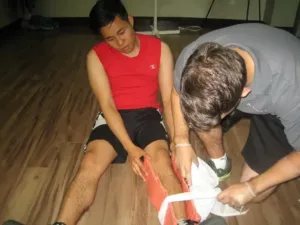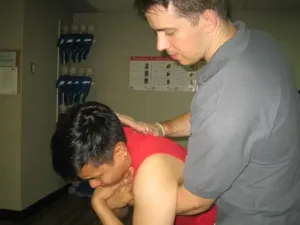Thunder Bay First Aid offers prospective trainees the lowest rates for training courses in first aid, cardiopulmonary resuscitation (CPR), and automated external defibrillation (AED). Training courses, stand-alone classes, private classes, and refresher courses are available throughout the week at varying schedules, so enrolling in a class of your choice is easy. An on-line application form is available below for quick registration to a training course of your choice. Enrolment may also be done through e-mail, telephone call, or walk-ins at the training center.
The Thunder Bay First Aid website can be viewed by clicking this link. Additional information on classes and schedules are available on the site.
About Thunder Bay First Aid
Rates

This provider features a range of workplace approved training and re-certification programs at the most affordable rates. All rates are inclusive of taxes, certificates, and workplace approved registration fees. No additional fees are usually spent by trainees, as all equipment and manuals are included in the initial enrolment fee. Thunder Bay First Aid is devoted to offering prospective trainees the most competitive prices onfor each of its training courses throughout Thunder Bay.
Training Courses
This St Mark James training provider is the only training service provider that offers a large selection of training courses and classes. CPR training courses come on 3 levels: “A”, “C”, and “HCP”.
The following is a list of stand-alone classes available at Thunder Bay First Aid:
-
The courses offered through Thunder Bay First Aid include training in first aid and CPR by “hands on” approaches by using mannequins such as the ones in the picture above. Standard first-aid
- Standard Childcare first aid and cardiopulmonary resuscitation
- Emergency 1st aid and cardiopulmonary resuscitation
- Emergency Childcare 1st aid
- Basic Marine 1st aid and CPR
- Babysitting first-aid
- CPR level “C” for health care providers
- Cardiopulmonary resuscitation level -A and AED
- Cardiopulmonary resuscitation (CPR) level -C and AED
All CPR training courses are inclusive of basic first aid and AED training. AEDs are machines used in conjunction with CPR, as part of the 2010 Basic Life Support (BLS) guidelines. BLS is introduced to first time trainees, as the guidelines highlight the pathway taken by rescuers performing CPR and AED on a victim of cardiac arrest. AEDs are machines that detect heart rhythms and provide shock (manually or automatically) to the victim.
Private classes are also offered to groups or companies who wish to enrol a large group of people in a separate class. Companies usually prefer private classes for skill development or team building activities, usually done at a particular schedule.
Certification

All CPR training courses are overseen by the St Mark James Training and successful completion give trainees a certificate for first aid, CPR, and AED, valid for 3 years all throughout Canada. Refresher courses are also offered twice a week for renewal of expiring or near-expiry certificates.
The short lesson below should give you an idea of what topics are covered by first aid classes. Enrol at Thunder Bay First Aid for high quality training at the lowest rates!
“Life Over Limb”
Students who register and attend workplace approved training courses will learn effective life-saving techniques. A popular saying is “Life over Limb”, that teaches participants the following:
If a life-threatening injury aggravates another injury, or suspected injury, the rescuer should tend to the life-threatening injuries as a priority. In other words, the “life” (breathing and circulation) takes priority over any secondary injury or “limb”. If a person is not breathing with a suspected spinal injury. It may be necessary to move the victim in order to save his or her life. The “life” takes priority over the “limb”.

